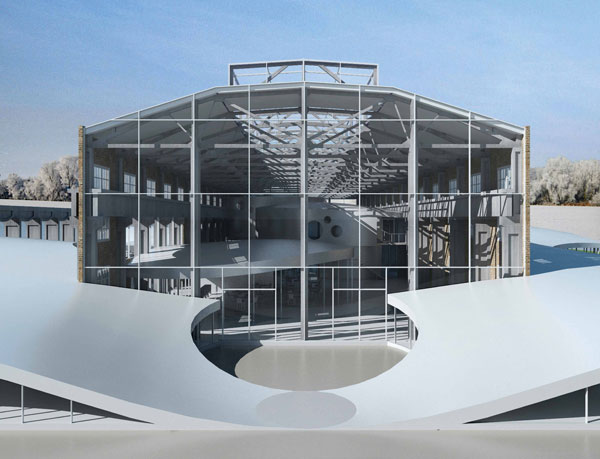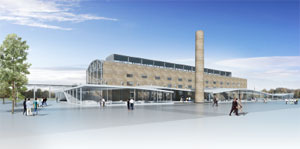 |
| Drawing courtesy of Serie Architects |
| To maintain the integrity of the old structure, the architects pushed some of the project's uses into a new one-story plinth. |

Drawing courtesy of Serie Architects
When Serie Architects was selected in March 2010 along with Grimshaw's London office and Berlin-based Pysall Ruge Architekten to transform a group of disused steel factory buildings in Hangzhou, into a new mixed-use complex, the firm faced a big challenge. The developer wanted Serie's project to provide office, exhibition, and retail space equal to four times the size of the old factory. "Even if we were to insert [the new program in the old building], we still would not have enough room," said Christopher Lee, co-founder of Serie, a small firm with offices in London, Mumbai, Chengdu, and Beijing. "We would also destroy the most attractive aspect [of the factory], which was the void and the concrete trusses. It would almost be a crime to fill it all up with retail." Unlike its colleagues' plans for the other buildings, Serie designed a solution that preserves the integrity of its old structure while delivering the floor space needed to make the project economically viable. "We were aware of [the other firms' designs], but everyone did what they felt was most appropriate," says Lee.
His team moved the program outside and compressed it into a one-story plinth. The plinth acts as a frame for the factory and also as a podium, elevating its importance and visibility, says Lee. The concrete plinth dips at critical places and is covered in some areas with grass. The interior of the building, with its 16-meter-high ceiling, remains an open, flexible space for exhibitions and trade shows. Serie also removed the cracked concrete panels on the roof and replaced them with solar panels. The architects saved the existing lantern, but reglazed it entirely. The new development, named Hangzhou Xin Tian Di, is about three miles from the current city center and is expected to attract creative industries.



